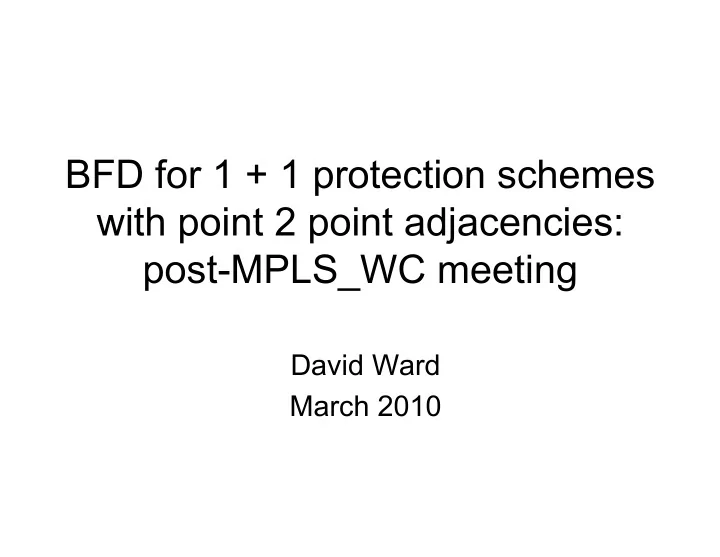

BFD for 1 + 1 protection schemes with point 2 point adjacencies: post-MPLS_WC meeting David Ward March 2010
Unidirectional LSP solution space
Unidirectional LSP solution • Use BFD for unidirectional LSPs with no or minimal change • draft-ietf-bfd-mpls (will you allow it by config as well?) • 4 sessions: 1 for each of the 1 + 1 links (rx and tx) • Each session is responsible for monitoring the live-ness of one unidirectional link The multi-hop “control response” channel should be over corresponding return path but, in a failure situation; the “control response” channel would come over paired path Pros: • Enables slow start easily • Enables ability to transmit diags • Completely BW compat and widely deployed • Technique works in all MPLS enviroments Cons: • requires at least one return path to restart a BFD session
Unidirectional LSP solution space LSP SA DA BFD A Act1 Pas2 Act3 Pas4 MyDisc:0xB2 YourDisc: 0xA1 1 2 3 4 Summary Pas1 Act2 Pas3 Act4 2 • Tx for session B->A over link 2 B • Rx for session A->B over link 1 or link 3 in case of failure • BFD control packets are encapsulated in the MPLS label stack that corresponds to the FEC under fault detection. • Egress LSR is single hop from BFD perspective, TTL is set to 1. • Egress LSR routes BFD packet based on the destination IP address.
Multipoint BFD overview and solution space
Multipoint BFD Overview • Verifies connectivity of head->tail multipoint path • Technology independent (IP mcast, MPLS P2MP, etc.) • Does not verify tail->head return path • Does not verify unicast head->tail path • Optional notification to head of tail status • Protocol timing/scalability driven entirely from head • Runs next to Classic Unicast BFD • Falls out of existing Unicast BFD spec (pretty much)
Original MP Service Definition • Base function plus a number of options • Options may be enabled in any combination • Base function: Unidirectional Transmission – Head sends periodic packets along MP tree • based on the discriminator distributed and specific to the head – Tails detect BFD timeout, do "the right thing" (e.g. listen to another head) – Head ignorant of tails, no BFD packets sent to head – Simple, extremely scalable
Service Definition - option 1 • Option: Solicit Membership – Head sets Poll bit in MP transmission – Tails send unicast Final in reply – Tail transmission smeared across time specified by head – Head gets a Pretty Good idea of tails listening (unreliable)
Service Definition - option 2 • Option: Tails notify head of session failure – Head directs tails to send periodic packets to head when tail detects session failure – Upon session failure, tail sends bfd.DetectMult packets (smeared across time) and then quiesces – Semi-reliable (multiple packets are sent)
Service Definition - option 3 • Option: Verify Connectivity of Specific Tail – Head sends unicast Poll Sequence to specific tail (learned by solicitation or outside means) – Tail replies with Final (and without smear, so it's quick) – Head reliably learns tail state (if tail ever replies)
Service Definition - option 4 • Option: Some Tails are More Equal Than Others – Side effect of unicast Poll Sequence is that intervals carried therein override multipoint values – Head can thus raise transmission rate of individual tails for failure notification
Service Definition - option 5 • Option: Silent Tails – Tails may be provisioned to never reply to BFD even when head sends Polls – Allows for large numbers of second-class citizens in class-conscious tail population
Session Types • Operation modeled as distinct session types: – PointToPoint: Classic BFD – MultipointHead: Session on head sending multipoint packets – MultipointClient: Optional session on head tracking individual tail – MultipointTail: Session on tail tracking head
Demultiplexing • Multipoint (M) bit flags multipoint packets • Packet demuxing rules select session • Session type determines elements of procedure
Protocol Tricks and Hackery • Multipoint packets all sent with Demand (D) bit set, tails cannot send periodic packets while session is up • Required Min RX value set to zero means "no periodic transmission ever" (controls failure notification) • Silent Tail = 1 means "no transmission ever" (no reply to polls)
Environmental Assumptions • Tail needs to be able to differentiate between packets received on different MP trees if same head is going to be heard from on multiple trees – Via discriminators specific to the head • Head is identified by source address (which cannot change)
Solution overview • In 1 +1 environment create 4 independent sessions: Head end (tx) driven – No fundamental savings • Enables receiver to have CC/CV independent of bidirectional connectivity • If use any functionality of options 1-4 then it is directly analogous to BFD for LSP solution though return control not required continuously NOTE: Need to make changes to enable slow start
Summary for MP for P2P links Two MP sessions over p2p links A One from A to B Another (separate) from B to A Options: Use ‘option 5’ Set D bit Set rx trans to 0 or make silent tail B
Summary • Existing MPLS-BFD is the choice that requires no extensions or modifications if any return path exists – Gives full functionality of slow start and messaging of tail to head • Case for MP functionality over P2P links is a small, corner case of P2P functionality – No return path – Functionality of MP option 5 and any other functionality is never required – Slow start without return path requires modifications • Recommendation: use MPLS-BFD procedures
Recommend
More recommend